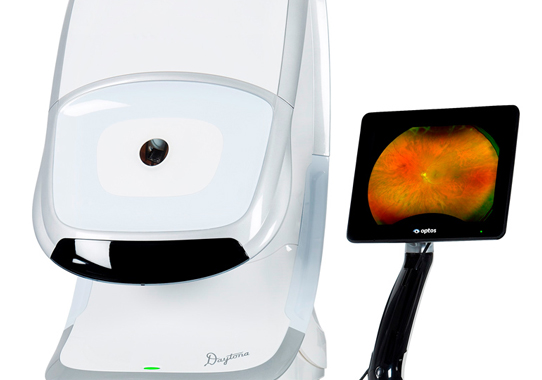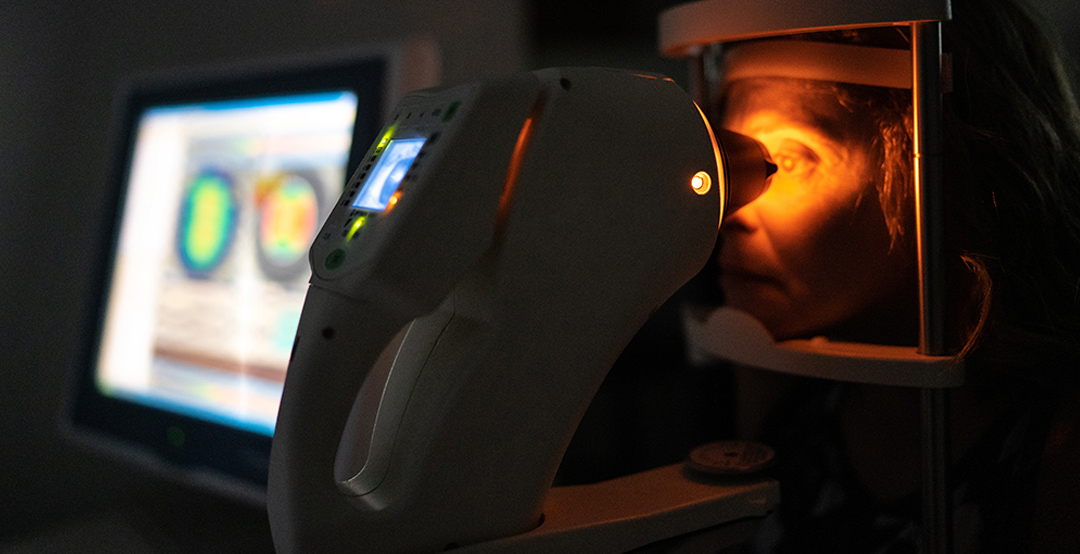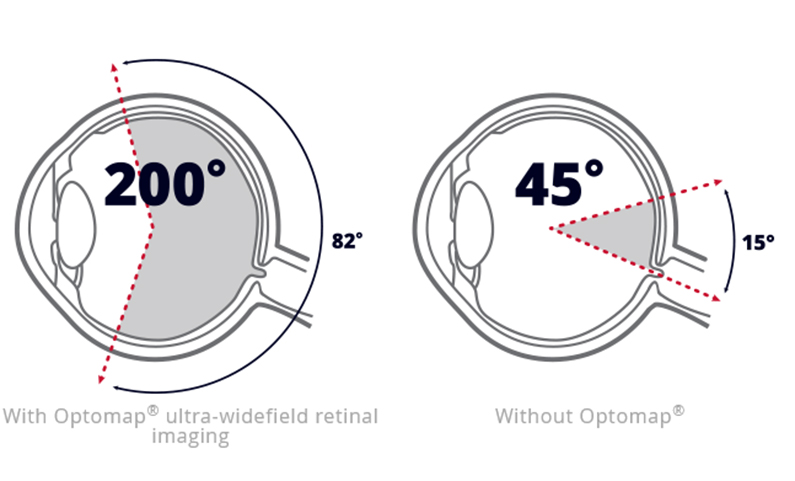 Main Menu
Main Menu

Wisconsin Vision offers dilation-free retinal imaging using Optos® technology at nine different locations:
- Elm Grove
- Janesville
- Pewaukee
- Franklin
- Appleton
- Greenfield
- Milwaukee Layton
- Madison West
- Racine

Why Optomap?
Optomap® retinal imaging has several advantages:

Efficient: Optomap® exams can be done right away. You don’t have to wait for dilating eye drops to take effect.
Convenient: Dilating eye drops can give you blurred vision and increased light sensitivity for hours. With Optomap® there’s no need for dilation.
Detailed: Traditional retinal imaging lets an optometrist view about 15% of the retina at a time. Optomap® wide-angle imaging captures a high-resolution view of more than 80% of the retina.
Archived: Unlike traditional retinal exams, Optomap® images can be saved to compare against future scans, or to share results with other doctors.
- No eye drops
- No waiting
- No side effects
- 200-degree view
- Retinal image saved in your record
- Requires dilating eye drops
- Wait up to 30 minutes for eye drops to work
- Side effects can include blurred vision & light sensitivity
- 45-degree view
- No visual record of exam
Optomap® does not replace dilation
Optomap® is an effective complement to dilated retinal exams because it provides a comprehensive view of almost the whole retina, and images can be used to monitor changes over time.
Depending on your eye health and the results of your Optomap® exam, your eye doctor may also require a dilated eye exam to further evaluate the retina and optic nerve.
Patients with diabetes need a dilated retinal exam to screen for retinopathy once a year, or as recommended by their eye doctor.
Eye Exams
Routine eye exams and vision testing are a crucial part of preventative health care. Early diagnosis of eye and vision problems can help prevent vision loss and detect warning signs of other serious health problems.
HOW MUCH IS AN EYE EXAM?
Right now we’re offering comprehensive eye exams for $49 at all Wisconsin Vision locations (contact lens examinations excluded, terms & conditions apply).
USING INSURANCE FOR AN EYE EXAM
At Wisconsin Vision we take more types of vision insurance and offer free coverage checks to make sure you’re getting the maximum benefits from your plan. If there are any out-of-pocket expenses associated with getting your eye exam, we’ll tell you exactly how it breaks down so you won’t have any surprises.
EYE EXAMS WITHOUT INSURANCE
Many of our patients don’t have vision insurance and are still able to afford regular comprehensive eye exams. We’ll always explain your best options, with or without insurance.
You can also use CareCredit for eye exams and eyewear at all Wisconsin vision locations, with interest-free financing for up to a year.
Contact Lens Exams
Whether you already wear contact lenses or are considering contacts for the first time, you may wonder why you need a separate eye exam, especially if you already have a prescription for eyeglasses.
Contact lens exams include additional tests just for contact lens wearers. These tests make sure you are prescribed the right type of contacts, and that wearing contact lenses isn’t hurting your eye health.
Why can’t I use my eyeglass prescription for contact lenses?
Eyeglass and contact lens prescriptions are very different. With glasses, your corrective lenses sit about 10-15 millimeters away from your eye, while contact lenses rest directly on the surface of the eye.
Both types of prescriptions include lens power and magnifying power. Contact lens prescriptions include individual eye measurements for a perfect fit.
How contact lens exams work
Contact lens eye exams begin like regular eye exams: your eye doctor checks your eyes for any possible health issues and tests your vision. Contact lens exams also include detailed eye measurements to determine the size and type of contacts you need, as well as a lens fitting and evaluation.
Optomap Cost
An Optomap® retinal exam at Wisconsin Vision is $40. This is separate from the cost of a comprehensive eye exam (which is typically covered by vision insurance).
Does vision insurance cover Optomap®?
In our experience, most vision plans don’t cover Optomap® unless there’s a medical need. We’re happy to do a free benefits check and let you know what your plan covers.
We take CareCredit, which can make paying for out-of-pocket costs more convenient.
Is an Optomap® retinal exam worth it?
Optomap® retinal exams are worth it for multiple reasons:
- Some patients avoid eye exams because they don’t like dilating eye drops. Optomap® removes this barrier.
- Optomap® images let you see your own retina. This is a great opportunity to ask questions and learn more about eye anatomy and health.
- Optomap® facilitates early detection of many different diseases affecting vision and overall health.
Professional Services
Children’s eye exams
Proper vision is essential for learning and safety. When children can’t see well, they may underperform in school or sports without realizing poor vision is to blame.
A brief vision screening by a pediatrician or at school is not the same as a comprehensive eye exam from an optometrist. Children need a thorough evaluation of their eyes and vision to detect and treat problems as early as possible.
Contact Lens Exams
Whether you already wear contact lenses or are considering contacts for the first time, you may wonder why you need a separate eye exam, especially if you already have a prescription for eyeglasses.
Contact lens exams include additional tests just for contact lens wearers. These tests make sure you’re prescribed the right type of contacts, and that wearing contact lenses isn’t hurting your eye health.
Senior Eye Care
For adults over age 60, keeping up with regular eye exams is very important – especially for patients with existing health or eye conditions. Comprehensive eye exams for seniors are performed by an optometrist (not a technician) at all Wisconsin Vision locations.

 Shop by
Shop by Frame Material
Frame Material  Lenses &
Lenses &  Blue Light
Blue Light Professional
Professional Dispensing
Dispensing
 Our Lab
Our Lab
 Contact Lens
Contact Lens
 Community
Community
 Join Our Team
Join Our Team
